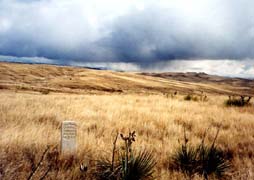Then we drove on [from St. Labre School] .. and drove into SNOW. The weather out here is banded by altitude, like sedimentation.
What you see blowing overhead is in your face as you climb up.
All that rain last night had been snow at the altitude of the
Custer campground. So we’d been smart to camp in Ashland? The
only smarting out here today is your face.
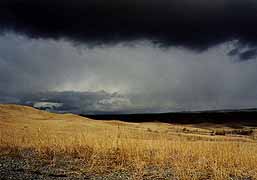
Prairie Weather
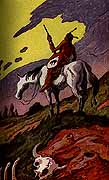
Sioux Warrior
(Thomas Hart Benton)
The sun played hideandseek with us through Lame Deer, along the
Rosebud and across the height of land to the Little Bighorn. We
had been following Custer’s fateful trail from Wibau, more or
less, and were now in sight of his doom. It’s ironic, perhaps,
that for the last day we have been in Indian country.. so they
won in the end, if reservations are a victory. It’s mighty hard
country on a bitter day, no matter which side of the horse you
get up on. Then there’s a barren hill to climb.
The site of Custer’s Last Stand wobbles your orbit. History and
present tense blur together. Instead of the usual statues and
obtrusive monuments, there is one marker on top of Custer Hill,
and then modest grave markers wherever remains were found. Tightly
encircled around George Armstrong, then scattered down the gullies
and across the sear grasslands. Your imagination is freed to hear
the hoofbeats and battle cries. The visitor’s center and a large
formal graveyard for other members of the 7th Cavalry are well
below the ridgeline, and you can approach the battleground on
foot, with nothing but the sky and your imagination between you
and 1876.
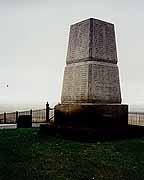
Monument
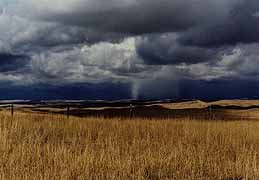
Battlefield hail
These sites of national memory portion off places out of time,
and we move through them in a ceremonial dance. When they are
combined with a striking landscape, as here, they let us sink
into the place as we never can in ordinary passage. Nobody is
surprised if you stop in the middle of the road and gawk, or get
out and scuff your feet in it. Even the weather has heightened
the drama for us. At Rushmore we rounded a mountain bend to see
Borglum’s work haloed by a rainbow. At the Little Bighorn Peggy
and I lurched up the hill in a cutting hail storm. Everyone else
ran for cover, but the flying black clouds, the beating wind,
and the sizzle of hail buffeted us into that other time.
We drove along the ridges to where Reno and Benteen were beleaguered,
and the groups of grave markers clustered in the bronzed grasses,
with the rolling, dipping and soaring prairie behind them, and
black flurries dancing on the horizon..well, mesons, ‘twas a sight.
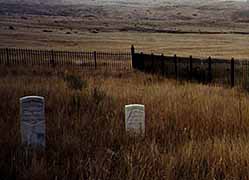
Graves
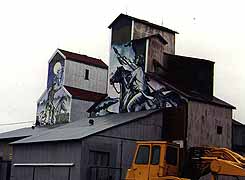
Local Art
We struck south for Wyoming, right into the maw of her. Blowing
wet snow, and the hills all dusted, the sudden black cattle between
flurries with their backs to it, and the rigs from Alberta blasting
by. By the time we hit Sheridan the sun was back out among the
high fields of cumulus, and the Bighorn Mountains standing behind
the town were white as winter. Peggy is on the edge of something,
and my stomach is still sore.. this road thing can get to you,
fellow travelers. The days begin to fuzz into each other. Sheridan
looks to be a real town. So we’re booked into an old fashioned
motel with purple butterflies on the separate cabins, a jiffylube
across the road, and a laundromat within hail. We may hang out
here until the wearies leave us. Assuming the modem works.
(Memo #21)
Sept. 26 B - Little Bighorn, Custer’s Last Stand Who? General George Armstrong Custer, Sitting Bull
What? national historic battlefield, monument, cemetery, visitor's
center
Where? hills overlooking Little Bighorn River in south central
Montana
When? June 25, 1876
How? part of long campaign
Topics: Plains wars, Native American history, Federal Indian policy,
George Custer, great Native American Leaders (Sitting Bull, Chief
Joseph, Pontiac, Black Hawk).
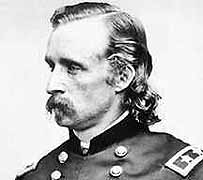
George Armstrong Custer
Questions: Was Custer’s last stand inevitable given the clash
of cultures & federal Indian policy? Was the disaster the result
of miscommunication and ignored orders during the battle? Could
the slaughter of Custer and his men have been prevented?
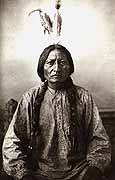
Sitting Bull
(Curtis photo)
It’s easy to have questions after the fact. The Battle of the
Little Bighorn led to the deaths of over 200 soldiers and one
of America’s most popular generals. It was inevitable that there
were questions (today there would be televised congressional hearings).
It was also a psychological shock to a nation that thought the
Plains tribes were basically under control and the march of western
civilization secure on the northern Plains. The image of perhaps
1200 warriors overpowering and massacring whole army companies
was chilling.
The site itself is incredible. There are few modern intrusions;
a monument on the hill where Custer fell and simple white headstone
where bodies of troopers were found. Each long hillside or ravine
will have three or four stark white markers. It is chilling. Appropriately,
we were hit by our first hail squall as we climbed the hill where
Custer died.
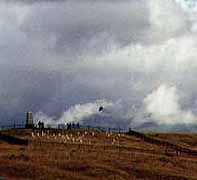
Last Stand
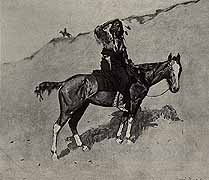
"Hostiles"
(Frederick Remington)
The US troops were there as part of the post Civil War thrust
to open the Plains for settlers and confine Native Americans to
reservations. Before the Civil War the Plains has been misperceived
as the ” Great American Desert”, a wasteland that separated settlers
from the good farmland of Oregon and Washington. It took a changed
view and a few inventions (a stronger metal plow for Plains turf,
drilled wells for deeper water, barbed wire for fences) to open
the Plains. Then the whites felt the nomadic tribes had to be
subdued.
By 1876 much of the Native American population had been subdued
by treaties and army actions and forcibly confined to reservation
lands. However, in the spring of 1876 many Indians (mainly Sioux
and Cheyenne) left the reservations. Their resistance to white
domination was solidifying under Chief Sitting Bull, Crazy Horse,
and other able leaders.
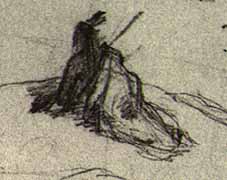
Scout
(sketch by Bodmer)
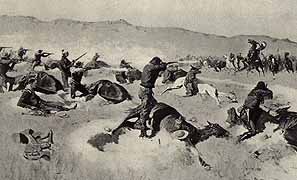
Remington
The army sent three expeditions to the northern Plains to meet
this threat. A battle in mid-June that engaged one expedition
was basically an Indian victory.Then the other two Army expeditions
met and planned the action for the Little Bighorn. Custer and
the 7th Cavalry were to go up the Little Bighorn River, Gen. Terry
would join Gen. Gibbon and would circle and approach from the
north.
On June 25 Custer’s scouts located the Indian village on the flats
by the river, but apparently underestimated the number of warriors.
Custer split his forces into three battalions. Basically each
column met a larger force than expected and was driven back from
the river up onto the series of hills to the east. Two of the
columns (under Reno and Benteen) joined and took a defensive position
on a high hill at the south end of the battlefield. Custer apparently
tried to cross the river to attack the huge village and was beaten
back and forced under heavy attack onto a small hill at the north
end of the battlefield. A message from Custer asking for assistance
did get through to the troops at the south end and led to an advance
by Capt. Weir that was beaten back. At this point the firing at
the north end of the battlefield (some four miles away) had stopped.
No one knew that Custer and his men had been surrounded and killed.
The other two battalions dug in and were under siege until the
approach of the Gibbon-Terry column from the north the next day.
It was then that the deaths of Custer and his companies were discovered.
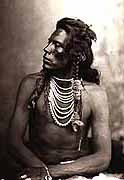
Crow Scout
(Curtis photo)
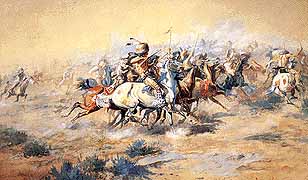
Charles Russell's Little Bighorn
There are Custer buffs who know each step in the action of June
2, 1876. I was in a discussion group on the cold terrace of the
visitor center that had visitors from all over asking detailed
questions, about a specific company or man or a specific ravine.
The Native American park ranger fielded every questions expertly
pointing to places on the battlefield as he talked.
The place itself answers many questions about the how and why
of the actual battle actions. Many people have wanted to know
why reinforcements did not reach Custer, why he was” left alone”
to face an overwhelming force. Reno and Benteen faced heavy questioning.
I think the answer is really simple.
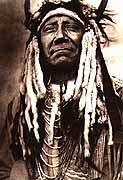
Two Moons
Cheyenne Warchief (Curtis)
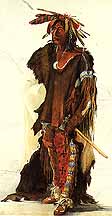
"Gallant Warrior"
Sioux Warrior
(Bodmer)
We drove the narrow winding road along the hills from Custer’s
hill to the hill Weir and his men climbed, to the fortified position
of Reno and Benteen. The land is cut by a huge number of ravines.
The impression of simple sweeps of grassland is false. Every sweep
has deep cuts and inclines from other directions. From the Reno-Benteen
hill you literally can’t see the Custer hill four miles away.
All reports are that there was smoke from hundreds of rifles and
dust from the thousand plus horses as well that made sight difficult.
There were small actions going on as four or five troopers made
a break for the river or retreated to the hills. The Sioux and
Cheyenne warriors cut out and circled groups and individuals (shown
by the widely scattered markers). What could be seen or heard
by Reno and Benteen was multiple actions. A large action on the
north where they thought Custer was located ended. Had Custer
retreated or dug in or been killed? Had the Indians retreated?
All of these were possibilities.
There are many stories about this event. Custer’s wife apparently
had a premonition. Custer himself had a dream of a warrior holding
up his long yellow hair in a scalp lock in victory and he had
his hair CUT before the battle. Chief Sitting Bull attempted to
get a vision before meeting the army. Custer was an ambitious
officer who had had reverses in his career. The scouts were Native
Americans who seriously underestimated the number camped on the
Little Bighorn.
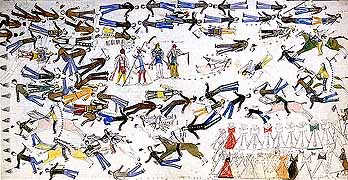
Kicking Bear's Little Bighorn
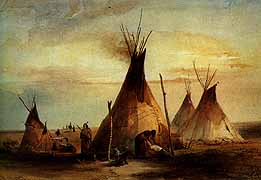
Sioux Camp 1834 (Bodmer)
Archaeology has been done at the site and yielded many artifacts
and a huge amount of information. They actually used computers
to “track” bullets from where they were dug up to recreate the
actions. The Indians leaders and the Reno/Benteen troops all added
to the knowledge. Scholars can mine a huge amount of data.
Few places we have visited have the impact of the Little Bighorn.There
seem to be bugles and battlecries in the winds that sweep these
grassy swells and deep ravines. Sioux warrior seem to be just
over the hill. I left shaken.
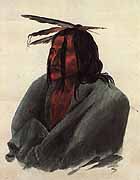
Sioux man
(Bodmer)
